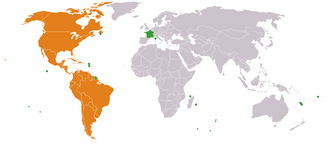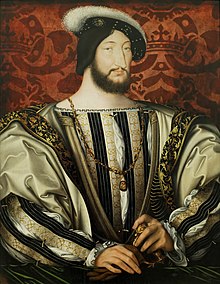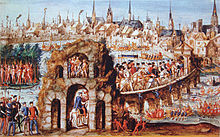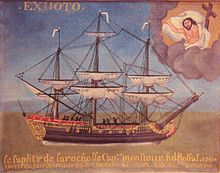France–Americas relations

France–Americas relations started in the 16th century, soon after the discovery of the New World by Christopher Columbus, and have developed over a period of several centuries.
Early encounters (16th century)

Expeditions under Francis I

In order to counterbalance the power of the

In 1524,
In 1531, Bertrand d'Ornesan, Baron de Saint-Blancard tried to establish a French trading post at Pernambuco, Brazil.[2]
In 1534, Francis sent
Early Huguenot colonists


Soon, the Huguenots, whose Reformist religions was in conflict with the French crown, attempted to colonize the New World to find a new ground for their religion and to contest the Catholic presence there.
Huguenot
The first attempts at colonization were made under vice-admiral Nicolas Durand de Villegaignon, who was joined later by Huguenots Pierre Richier and Jean de Léry. After the short-lived establishment of France Antarctique in Brazil from 1555 to 1567, they had to abandon, and finally resolved to make a stand back in France, centering on the city of La Rochelle for the organization of resistance.[4]
The first French expedition to Florida occurred in 1562, composed of Protestants, and was led by Jean Ribault and permitted the short-lived establishment of Fort Caroline, named after the French king Charles IX.[5]
These first attempts at Huguenot colonization would be taken over by
Expansion (17th century)
North America

Towards the end of his reign
In 1632,
The French colonial drive increased in the 17th century, the "conquest of the souls" being an integral part of the constitution of
In France, the Huguenots were finally defeated by Royal forces in the
South America

A colonizing party of 500 and a mission of four Franciscans were sent under a 1611 patent letter from the Regent
The colonial enterprise to found "
In 1624, settlement along the South American coast in what is today French Guiana began.
West Indies
The French also started to establish smaller but more profitable colonies in the
The
The most important Caribbean colonial possession did not come until 1664, when the colony of Saint-Domingue (modern Haiti) was founded on the western half of the Spanish island of Hispaniola.
Consolidation and conflict (18th century)
Triangular trade


On 21 September 1711, in an 11-day battle, the Corsaire René Duguay-Trouin captured Rio de Janeiro in the Battle of Rio de Janeiro with twelve ships and 6 000 men, in spite of the defence consisting of seven ships of the line, five forts and 12 000 men; he held the governor for ransom.[10] Investors in this venture doubled their money, and Duguay-Trouin earned a promotion to Lieutenant général de la Marine.
Territorial conflicts in the North

Northern America became an important theater of the conflict between France and Great Britain in the
To compensate its ally, Spain, for its loss of Florida to the British, France ceded its control of French Louisiana west of the Mississippi. France's colonial presence north of the Caribbean was reduced to the tiny islands of Saint Pierre and Miquelon, confirming Britain's position as the dominant colonial power in North America.
The eastern half of Hispaniola (modern Dominican Republic) also came under French rule for a short period, after being given to France by Spain in 1795.
American war of independence
France soon became again involved in North America, this time by supporting the American revolutionary war of independence. A Franco-American alliance was formed in 1778 between Louis XVI's France and the United States, during the American Revolutionary War. France successfully contributed in expelling the British from the nascent United States. The Treaty of Paris was signed on 3 September 1783, recognizing American independence and the end of hostilities.
When the French Revolution led to war in 1793 between Britain (America's leading trading partner), and France (the old ally, with a treaty still in effect), Washington and his cabinet decided on a policy of neutrality. In 1795 Washington supported the Jay Treaty, designed by Treasury Secretary Alexander Hamilton to avoid war with Britain and encourage commerce. The Jeffersonians vehemently opposed the treaty, but Washington's support proved decisive, and the U.S. and Britain were on friendly terms for a decade. However the foreign policy dispute polarized parties at home, leading to the First Party System.[11][12]
The Jay Treaty convinced Paris that the United States was no longer a friend. By 1797 the French were openly seizing American ships, leading to an undeclared war known as the
19th century
Loss of Saint-Domingue
On August 22, 1791, a widespread slave rebellion began the Haitian Revolution, which culminated with the establishment of the independent Empire of Haiti in 1804.
Sales of Louisiana to the United States (1803)
Mexico intervention

Under
French role in the American Civil War
During the American Civil War, Napoleon III positioned France to lead the pro-Confederate European powers. For a time, Napoleon III inched steadily toward officially recognizing the Confederacy, especially after the crash of the cotton industry and his exercise in regime-changing in Mexico. Some historians have also suggested that he was driven by a desire to keep the American states divided. Through 1862, Napoleon III entertained Confederate diplomats, raising hopes that he would unilaterally recognize the Confederacy. The Emperor, however, could do little without the support of the United Kingdom, and never officially recognized the Confederacy.
During the tail end of the 19th century French foreign policy was focused on the Scramble for Africa, colonies in Asia, dealing with rising Germany in Europe. The Americas were not a priority concern.
20th century
French relations with the New World suddenly became of great importance, in the context of a wider search for new allies, once France was
Following the war, France was again occupied with European and colonial matters, and especially with the threat of German rearmament. Following the
Following the war, France entered into the
Since the 1950s, France has also been involved in building the
21st century
This section needs expansion. You can help by adding to it. (March 2010) |
Security relations between France and the United States were greatly strengthened by the aftermath of the September 11 attacks in 2001, and France's participation in the American-led invasion of Afghanistan. This closeness was short lived, however. Political relations between France and the United States were strained by vocal French popular and governmental opposition to the 2003 US-led invasion of Iraq. However, most New World nations, especially the more populous ones, sided with France and not the United States on this occasion. El Salvador, the Dominican Republic, Honduras, Nicaragua participated in Multi-National Force – Iraq, whereas the governments of Argentina, Brazil, Canada, Chile, Cuba, Dominica, Ecuador, Mexico, and Venezuela were publicly in opposition to the Iraq War.
Since the replacement of George W. Bush and Jacques Chirac by Barack Obama and Nicolas Sarkozy, respectively, Franco-US relations have improved. France has been involved in disputes with Latin American countries, however, including with Colombia over the fate of Íngrid Betancourt, and with Mexico over Florence Cassez. Relations with Canada under Stephen Harper are quite close.[citation needed]
The election of US President
France now has three
In 2015, Martinique joined the Organisation of Eastern Caribbean States (OECS); this was followed by Guadeloupe in 2019 which acquired associate member status, and the Collectivity of Saint Martin which was also admitted as an observer member of the bloc. There is also uninhabited Clipperton Island off the west coast of Central America.
See also
- France–Africa relations
- France–Asia relations
- French colonial empire
- French colonization of the Americas
- Overseas France
- African, Caribbean and Pacific Group of States
- EU-ACP Economic Partnership Agreements)
- ACP-EU Development Cooperation
- Association of Caribbean States (ACS)
- Organisation of Eastern Caribbean States
Notes
- ^ a b North America: the historical geography of a changing continent Thomas F. McIlwraith, Edward K. Muller p.39ff [1]
- ^ Renaissance Warrior and Patron: The Reign of Francis I by R. J. Knecht p.375 [2]
- ^ ISBN 978-1-84520-374-0
- ^ Fortress of the soul: violence, metaphysics, and material life by Neil Kamil p.133 [3]
- ^ Ceremonies of possession in Europe's conquest of the New World, 1492–1640 by Patricia Seed p.48 [4]
- ^ From a watery grave by James E. Bruseth
- ^ The Cambridge history of the native peoples of the Americas p.110
- ^ a b c d Decentring the Renaissance by Germaine Warkentin p.103ff
- ^ a b c A new world of animals Miguel de Asúa, Roger French p.148
- ^ The influence of sea power upon history, 1660–1783 Alfred Thayer Mahan p.230 [5]
- ^ Samuel Flagg Bemis, Jay's Treaty: A Study in Commerce and Diplomacy (1923)
- ^ Bradford Perkins, The First Rapprochement: England and the United States, 1795–1805 (1955).
- ^ Alexander De Conde, The quasi-war: the politics and diplomacy of the undeclared war with France 1797–1801 (1996).
Further reading
- Anderson, Fred. Crucible of War: The Seven Years' War and the Fate of Empire in British North America, 1754–1766 (2007).
- Blumenthal, Henry. France and the United States; Their Diplomatic Relation, 1789–1914 (1970).
- Boucher, Philip P. France and the American Tropics to 1700: Tropics of Discontent? (2007).
- Brazeau, Brian. Writing a new France, 1604–1632: empire and early modern French identity (2009).
- Dickason, Olive Patricia. The Myth of the Savage: and the Beginnings of French Colonialism in the Americas (1984).
- Eccles, W. J. The Canadian Frontier, 1534–1760 (1983).
- Eccles, W. J. France in America (1990).
- Moogk, Peter N. La Nouvelle France: the making of French Canada: a cultural history (2000).
- Roberts, Walter Adolphe. The French in the West Indies (1971).
